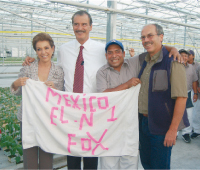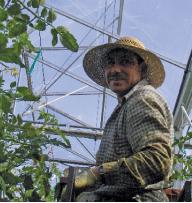
Features
Business
Grower Profiles
‘Welcome to Canada’: WALI working to make farms a home away from home
September 2, 2008 By Peter Mitham
The growing number of foreign
workers on British Columbia farms is spurring the industry to focus on
best practices for managing this important component of the province’s
agricultural work force.
 |
| Former Mexican president Vicente Fox toured Houweling in 2005. Photo courtesy Houweling Nurseries |
The growing number of foreign workers on British Columbia farms is spurring the industry to focus on best practices for managing this important component of the province’s agricultural work force.
Up to 3,000 workers from Mexico and the Commonwealth Caribbean countries could arrive in B.C. this year through the province’s Seasonal Agricultural Worker Program, now in its fifth year. The province’s greenhouses typically employ a tenth of the workers, while the rest are contracted to work with growers throughout the province in a wide variety of commodities. Additional workers are brought in through other initiatives, such as the low-skill worker program.
Growers’ access to foreign worker programs is co-ordinated by the Western Agricultural Labour Initiative, an organization established in February 2007 to facilitate farm employers’ dealings with government and relationships with foreign employees. Though not all employers work with WALI, the organization is a government-recognized advocate for employers and maintains a database of worker housing reports as well as correspondence regarding other incidents that may prove contentious.
Mike Wallis, the former executive director of the B.C. Raspberry Industry Development Council who was instrumental in establishing a foreign agricultural worker program for B.C. in 2004, took the helm of WALI at the end of January.
Speaking to growers at the Pacific Agriculture Show in Abbotsford, Wallis said improving management of a farm’s foreign worker program can ensure that workers complete tasks promptly, ensure the program is a benefit to both the employer and the employee, and can help improve planning for future needs.
“It has to be mutually beneficial and it has to be sustainable for both parties,” Wallis said of the relationship between farmer and foreign worker.
 |
| Angel Sanchez of Houweling Nurseries Photo by Peter Mitham |
DEVELOP STRATEGIES FOR EFFECTIVE TIME MANAGEMENT
To make things easier for all concerned, Wallis encourages growers to develop strategies that make the best use of the time available to both themselves and their workers. A schedule for regular tasks such as groceries is helpful, for example, because it makes workers’ lives a little more predictable and comfortable. Similarly, knowing the location of the closest medical clinic and other services that are best suited to serving foreign workers saves time in the event of an emergency.
These are basic points that can be incorporated as part of a basic orientation to the farm and the surrounding community that employers should provide when workers first arrive. An orientation session and the setting of ground rules are important, Wallis said, so that everyone knows what is allowed and what isn’t. This will also reassure workers, who will know who to contact, what to do and where to go whether in the course of their day or in the event of an emergency.
Of course, clear communications are integral to good relationships. This goes beyond the basics of having Spanish-language signs (in the case of workers from Mexico) or translators on staff.
Communication can be both verbal and non-verbal, Wallis said, noting that growers have to be keenly aware of the signals they’re sending when dealing with workers.
 |
| Mexican president Vicente Fox watched a grafting demonstration during his tour of Houweling Nurseries in 2005. Photo courtesy Houweling Nurseries |
PATIENCE IN EXPLAINING WORKPLACE PROCEDURES
Raising your voice doesn’t necessarily make a point clearer, for example. Sometimes, what is needed is the patience to explain something in terms the worker can understand.
“If communications are running in both directions, it’s going to make the program run smoother,” Wallis said.
A failure to follow through on promises won’t help, either, Wallis said. He gave the example of a grower whose workers were refusing to work. When the situation was reviewed, it was found that the employer hadn’t fulfilled a promise to fix the stove. The situation was easily resolved but at a cost to the respect in which workers held the grower.
Similarly, Wallis urged growers to be firm but fair in enforcing the ground rules, lest they compromise the authority they have with workers.
WALI has just two people on staff right now, but Wallis hopes the organization will be able to hire additional people in order to provide support services to employers.
Current funding for the program runs out in December 2008, but WALI has submitted a business plan to the Ministry of Agriculture and Lands and the Investment Agriculture Foundation in the hope of securing additional funding. It also charges a fee of $45 per worker for every placement or transfer it makes.
Participants in the B.C. seasonal workers’ program work solely in production positions such as harvesting. Work contracts are for a minimum of 240 hours over the course of a period not to exceed eight months.
Wages this year are set at $8.90 an hour (plus four per cent vacation pay), steady with last year’s rate after increasing 30 cents a year in each of the previous three years.
Service Canada is studying wage rates with a view to establishing a fair wage for SAWP workers, however, which could see rates change in 2009.
Additional information on B.C.’s foreign worker programs as well as WALI’s operations is available online at the initiative’s new website, www.walicanada.com .
Print this page